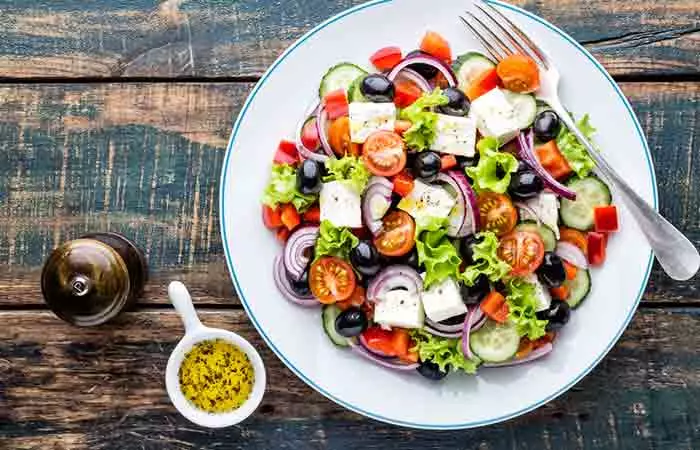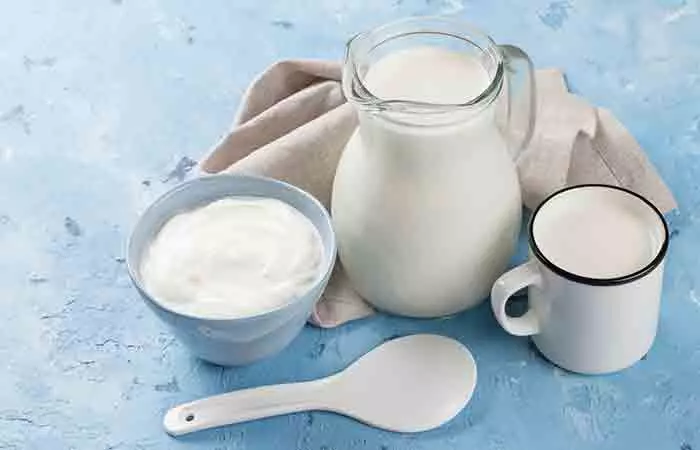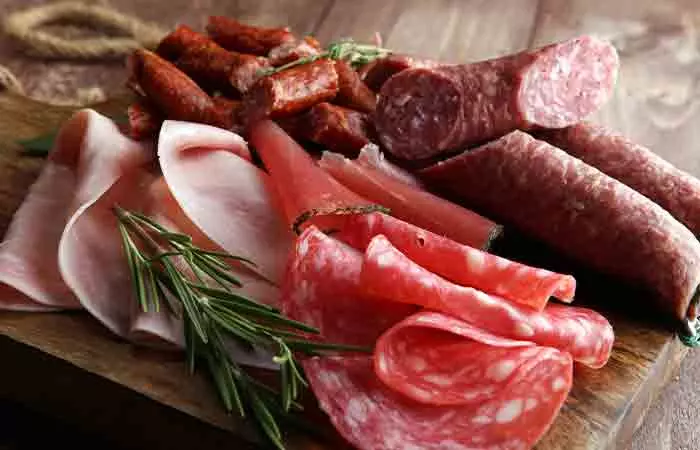However, lactating and pregnant women are a big no for taking up this diet. This article explains what this diet is all about, its benefits, and its potential risks. Read on!
What Is The 500 Calorie Diet Plan?
The 500 calorie diet is an extreme form of a very low-calorie diet, i.e., it is extremely low in calories. It replaces the normal food routine with liquid supplements, meal replacement shakes, and bars for a specific period (1). Having dietary supplements or meal replacements has become widespread in the US. According to the National Health and Nutrition Examination Survey, 2017– March 2020, over one-third of adolescents and nearly three out of five adults consume dietary supplements. This restricted calorie consumption may help your body use the stored fuel source, i.e., fat. This, in turn, helps you shed pounds. This is a type of 5:2 intermittent fasting plan that involves severe energy restriction for two non-consecutive days of a week and consuming 2000 calories on the other five days. This type of modified diet can fulfill 20-25% of energy needs on fasting days (2). Lifestyle blogger Jaya Jha successfully lost weight by following a 5:2 calorie-deficit diet. She said, “Between September last year and May this year I lost 8+ Kgs from my peak weight (i).” However, she faced setbacks during vacations, holidays, and work trips. She considered this weight loss a significant milestone and aimed to maintain her current weight or lose more weight with the diet. Studies showed that hypocalorici A very low-calorie diet with extremely low daily food energy consumption. Also known as semistarvation. intermittent fasting could help overweight and obese individuals lose weight. However, these studies are inconclusive, and more research is needed to confirm these findings (3). What should your 500-calorie diet plan look like? Scroll down to find out. Note: Before starting the 500-calorie diet, it is essential to consult a healthcare professional. This diet is not suitable for everyone. So, follow this very low-calorie diet (VLCD) only under the supervision of a doctor or a nutritionist.
A 500-Calorie Sample Meal Plan For Weight Loss
As part of the 5:2 diet plan, you need to be on a low-carb diet for two days. But what exactly should you eat?
1. Breakfast
Tip: If you feel hungry before lunch, you can drink a cup of green tea without sugar.
2. Lunch
Tip: Drink a glass of lukewarm water 20 minutes before lunch to avoid overeating.
3. Dinner
Tip: Drink water, and if you feel hungry, have a glass of coconut water or unstrained vegetable juice. You can choose from these options and create an ideal, customized diet plan suitable for you. Make sure you consult your doctor and dietitian before starting this diet. What are the benefits of the 500-calorie diet? Find out in the next section.
Benefits
The main benefit of the 500-calorie meals is that they may aid in rapid weight loss. Following a VLCD may help revamp your metabolism. It accelerates fat oxidation, helping you shed weight (4). It is great for those who need to lose weight to prevent any health risks. But what if you are on this diet even if you don’t need to? Or what if you are on a 500-calorie diet for three weeks or more without being supervised by a doctor? Is a 500-calorie diet healthy and safe in such a case? Find out in the next section.
Is 500 Calories A Day Healthy?
No, 500 calories a day is not healthy, especially if you are doing it without a doctor’s supervision for an extended period. Yes, you may lose some weight initially. But this is not sustainable as you may regain the lost weight once you go back to your regular diet. Further, thi low-calorie diet can be mentally and emotionally taxing and lead to an unhealthy relationship with food. Research suggests that calorie counting could trigger symptoms of eating disorders such as food anxiety and purging behavior (5). Apart from this, low-calorie diets are also linked with an increased risk of nutritional deficiencies, muscle loss, and the development of gallstones. Learn more about these health risks in the next section.
Health Risks
1. Nutritional Deficiencies
Following a 500-calorie diet plan for long leads to nutritional deficiencies. A study published in the Nutrition Journal showed that a very low-calorie diet formula could lead to micronutrient deficiencies (6). There was a significant reduction in the serum concentration of vitamin D, vitamin C, and zinc among obese people on a low-calorie diet for over 12 weeks (6). Low-calorie diets can cause nausea, fatigue, diarrhea, intolerance to colds, menstrual irregularities, and hair loss. Lack of fiber in the diet can also cause constipation. This decreases the efficiency of the immune system and makes your body vulnerable to various ailments. Jesse Feder, Registered Dietitian, says, “ A person can only survive short term on 500 calories a day. This is extremely low and can lead to serious health issues over time.”
2. Muscle Loss
Do you want to lose weight? Then, lose fat, not muscle. If you are on a VLCD for a prolonged period, you will start losing muscle mass instead of fat mass and might end up not liking your body transformation. A very low-calorie, low-carbohydrate, low-protein diet can cause skeletal muscle loss (7). This can give you a “slim-fat” look and make your skin loose and droopy.
3. Metabolic Changes
Following a very low-calorie diet for a long period slows down metabolism. This ultimately leads to weight gain when you return to the original eating pattern. A study published in Nutrition & Metabolism showed that a sudden reduction in body weight due to a low-calorie diet plan reduced the resting metabolic rate (RMR), but it was not as expected (8).
4. Decrease In Bone Mass
Weight loss due to following a calorie-restricted diet for a long time decreases bone mineral density and weakens bone strength (9). A study showed that low-calorie diet-induced weight loss is accompanied by a loss of bone mass (10). Another study on 48 adults showed that calorie restriction (CR) reduced bone mineral density and bone mass (11).
5. Development Of Gallstones
Following a very low-calorie diet (500 calories) can increase the risk of developing gallstones. A study published in the International Journal of Obesity showed that following VLCD for over one year resulted in cholelithiasis (the formation of stones in the gallbladder). Many of the adults had to undergo cholecystectomy (removal of the gallbladder) (12).
6. Deficiency Of Healthy Fat
A low-calorie diet is devoid of healthy fats to restrict unnecessary calorie intake. Consuming healthy fats in portion control provides satiety and helps you stay healthy (13). Following a very low-calorie diet with restricted healthy fat intake reduces the absorption of fat-soluble vitamins, leading to deficiency (14). You may be wondering who can follow this diet and who should avoid it. Find the answers below.
Who Can Follow The 500-Calorie Diet?
People with a BMI of more than 30 (from obesity grade I to grade III) should follow a very low-calorie diet under the proper supervision of a doctor or a nutritionist.
Who Should Avoid A Very Low-Calorie Diet?
Generally, doctors do not allow people with medical conditions to follow a VLCD. It is advisable not to follow any calorie-restricted diet under the following clinical conditions:
Heart disease Diabetes Kidney diseases Gout (accumulation of uric acid in joints) Gallstones
There are a lot of foods that are low in calories or marketed as low or zero-calorie drinks or foods but are harmful to the body. Hence, you should be aware while making food choices. You should have a clear idea of what to eat and avoid if you are on a 500-calorie diet. Higher calorie diets such as the 1200 calorie diet plan may be recommended instead if you have any medical condition.
Foods To Eat On The 500-Calorie Diet
Non-starchy vegetables like broccoli, carrot, beetroot, scallion, cabbage, lettuce, and parsnip. These are low in calories and loaded with nutrition. They will make you lose weight without putting your health in danger. Salads, sautéed, stir-fried, and blanched food. These minimize the disruption of valuable enzymes and phytonutrients.
Full-fat milk and yogurt. Full-fat versions are more nutritious and will help keep hunger at bay.
Fruits and freshly pressed fruit juices. Make sure you don’t consume high GI foods like mangoes, pineapple, and grapes. Low-calorie salad dressing like olive oil, lime juice, salt, and pepper. Pre-cooked chicken and shrimps. Pre-washed veggies.
Here’s the list of foods you must avoid while on the 500-calorie diet.
Foods To Avoid On The 500-Calorie Diet
The foods listed below are unhealthy and have a high calorie count. So most diets, including high caloric ones such as the 1300 calorie diet plan, avoid them altogether.
Processed foods like sausages and salami.
Canned veggies, fruits, etc. Energy drinks, soda, and bottled fruit juices. Dried fruits. Sugary foods like cake, pastry, pancake, and candies.
How many pounds will I lose if I eat 500 calories a day? Check out the below infographic to learn how to suppress hunger pangs while on the 500-calorie diet. Following a VLCD (500 calories per day) can help you reduce 15-20 pounds in a month. How much weight can you lose per week on the 5:2 diet? The 5:2 diet plan can help you lose 5-7 pounds in a week, depending on your body type. What recipes can I include in a 500-calorie diet? Foods that are loaded with low-calorie vegetables and fruits can be included in a 500-calorie diet. You can make vegetable soup, vegetable salad, fruit salad with low-fat yogurt, or a portion of grilled chicken or fish with grilled veggies for lunch or dinner to satisfy your hunger pangs. Can I follow a 500-calorie diet for 3-4 weeks? Following a very low-calorie diet (500 calories) for more than a week makes your body weak and lowers your immunity and productivity. Hence, it is important to consult your doctor and dietitian before following a VLCD for a long time. What types of snacks can I eat on a 500 calorie diet? Eat healthy and low calorie snacks like fruit bowls, trail mixes with dry fruits, nuts and seeds, cut veggies with hummus, and hard-boiled eggs. Is it necessary to exercise while on a 500 calorie diet? It is not necessary to exercise while on this diet. If you try to exercise you could feel exhausted because of your low calorie intake. Exercise after three to four hours of eating a full meal and consume a low-fat, moderate-protein snack 30 minutes before working out for an energy boost. You can also try the 1000 calorie diet if you do not want to miss workouts.












